Chung Shue Chen
LINCS
VLMLight: Traffic Signal Control via Vision-Language Meta-Control and Dual-Branch Reasoning
May 26, 2025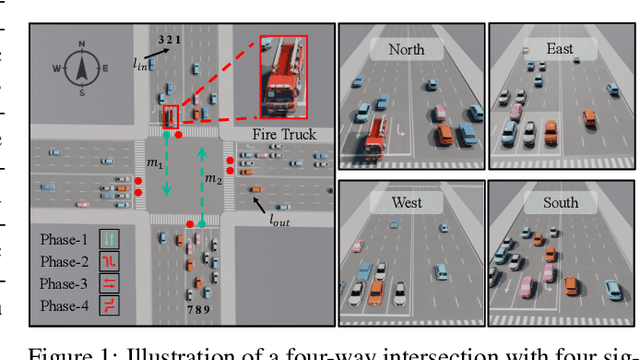
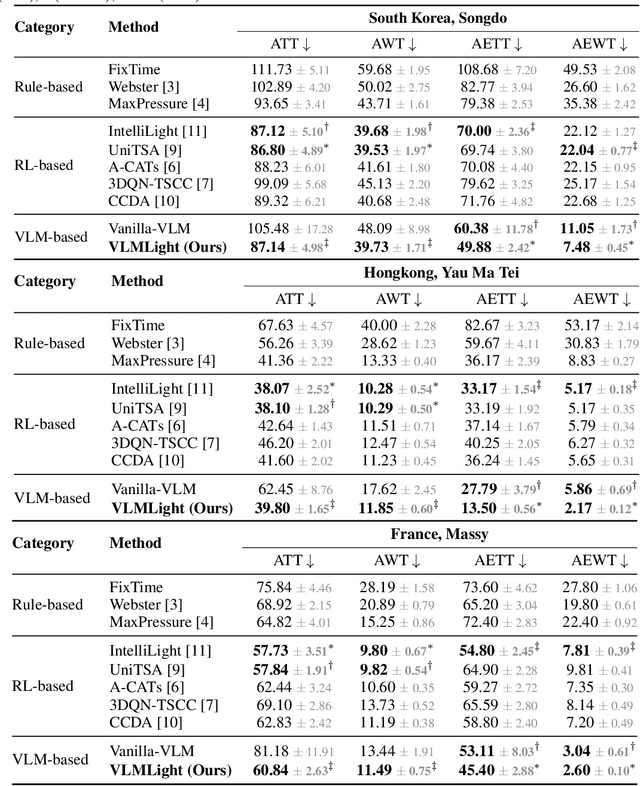
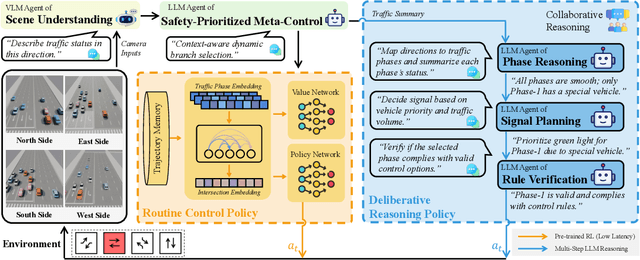

Abstract:Traffic signal control (TSC) is a core challenge in urban mobility, where real-time decisions must balance efficiency and safety. Existing methods - ranging from rule-based heuristics to reinforcement learning (RL) - often struggle to generalize to complex, dynamic, and safety-critical scenarios. We introduce VLMLight, a novel TSC framework that integrates vision-language meta-control with dual-branch reasoning. At the core of VLMLight is the first image-based traffic simulator that enables multi-view visual perception at intersections, allowing policies to reason over rich cues such as vehicle type, motion, and spatial density. A large language model (LLM) serves as a safety-prioritized meta-controller, selecting between a fast RL policy for routine traffic and a structured reasoning branch for critical cases. In the latter, multiple LLM agents collaborate to assess traffic phases, prioritize emergency vehicles, and verify rule compliance. Experiments show that VLMLight reduces waiting times for emergency vehicles by up to 65% over RL-only systems, while preserving real-time performance in standard conditions with less than 1% degradation. VLMLight offers a scalable, interpretable, and safety-aware solution for next-generation traffic signal control.
iLLM-TSC: Integration reinforcement learning and large language model for traffic signal control policy improvement
Jul 08, 2024
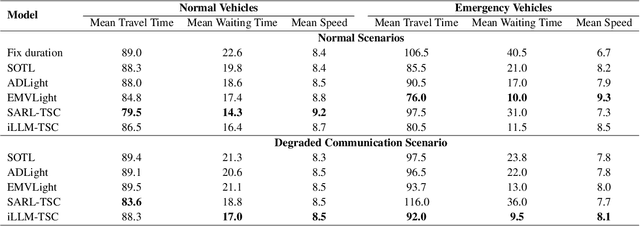
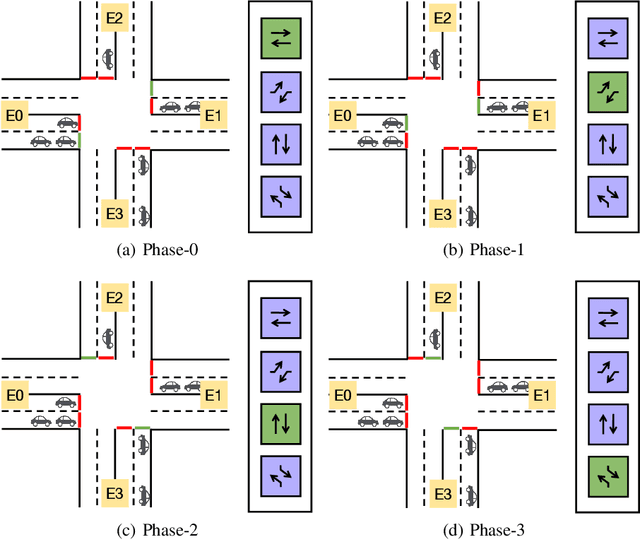

Abstract:Urban congestion remains a critical challenge, with traffic signal control (TSC) emerging as a potent solution. TSC is often modeled as a Markov Decision Process problem and then solved using reinforcement learning (RL), which has proven effective. However, the existing RL-based TSC system often overlooks imperfect observations caused by degraded communication, such as packet loss, delays, and noise, as well as rare real-life events not included in the reward function, such as unconsidered emergency vehicles. To address these limitations, we introduce a novel integration framework that combines a large language model (LLM) with RL. This framework is designed to manage overlooked elements in the reward function and gaps in state information, thereby enhancing the policies of RL agents. In our approach, RL initially makes decisions based on observed data. Subsequently, LLMs evaluate these decisions to verify their reasonableness. If a decision is found to be unreasonable, it is adjusted accordingly. Additionally, this integration approach can be seamlessly integrated with existing RL-based TSC systems without necessitating modifications. Extensive testing confirms that our approach reduces the average waiting time by $17.5\%$ in degraded communication conditions as compared to traditional RL methods, underscoring its potential to advance practical RL applications in intelligent transportation systems. The related code can be found at \url{https://github.com/Traffic-Alpha/iLLM-TSC}.
LLM-Assisted Light: Leveraging Large Language Model Capabilities for Human-Mimetic Traffic Signal Control in Complex Urban Environments
Mar 13, 2024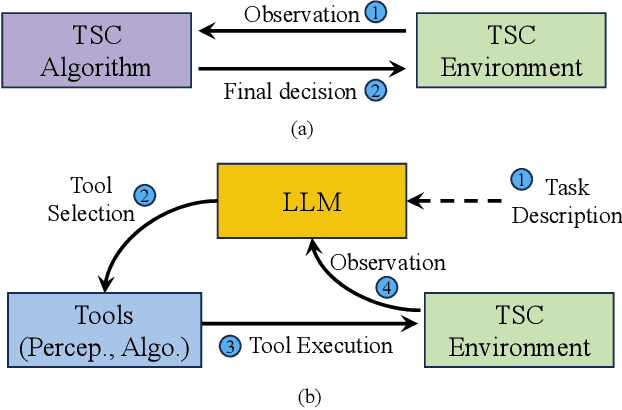
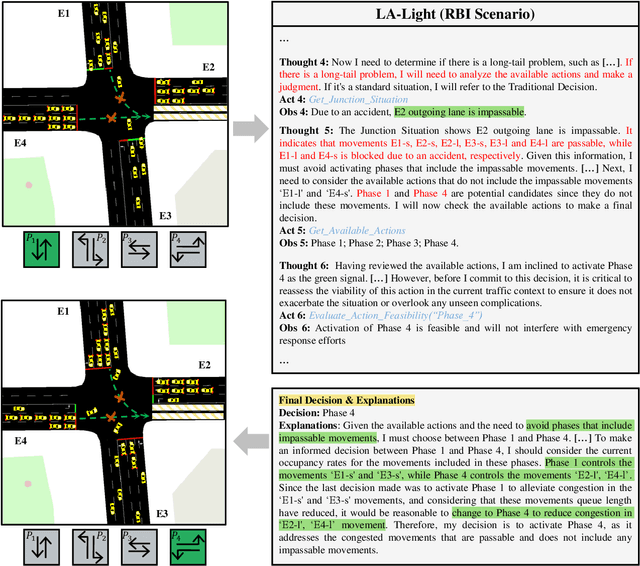

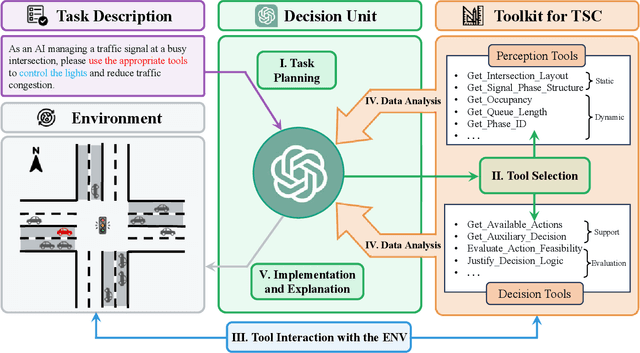
Abstract:Traffic congestion in metropolitan areas presents a formidable challenge with far-reaching economic, environmental, and societal ramifications. Therefore, effective congestion management is imperative, with traffic signal control (TSC) systems being pivotal in this endeavor. Conventional TSC systems, designed upon rule-based algorithms or reinforcement learning (RL), frequently exhibit deficiencies in managing the complexities and variabilities of urban traffic flows, constrained by their limited capacity for adaptation to unfamiliar scenarios. In response to these limitations, this work introduces an innovative approach that integrates Large Language Models (LLMs) into TSC, harnessing their advanced reasoning and decision-making faculties. Specifically, a hybrid framework that augments LLMs with a suite of perception and decision-making tools is proposed, facilitating the interrogation of both the static and dynamic traffic information. This design places the LLM at the center of the decision-making process, combining external traffic data with established TSC methods. Moreover, a simulation platform is developed to corroborate the efficacy of the proposed framework. The findings from our simulations attest to the system's adeptness in adjusting to a multiplicity of traffic environments without the need for additional training. Notably, in cases of Sensor Outage (SO), our approach surpasses conventional RL-based systems by reducing the average waiting time by $20.4\%$. This research signifies a notable advance in TSC strategies and paves the way for the integration of LLMs into real-world, dynamic scenarios, highlighting their potential to revolutionize traffic management. The related code is available at \href{https://github.com/Traffic-Alpha/LLM-Assisted-Light}{https://github.com/Traffic-Alpha/LLM-Assisted-Light}.
Experimental Comparison of Ensemble Methods and Time-to-Event Analysis Models Through Integrated Brier Score and Concordance Index
Mar 12, 2024

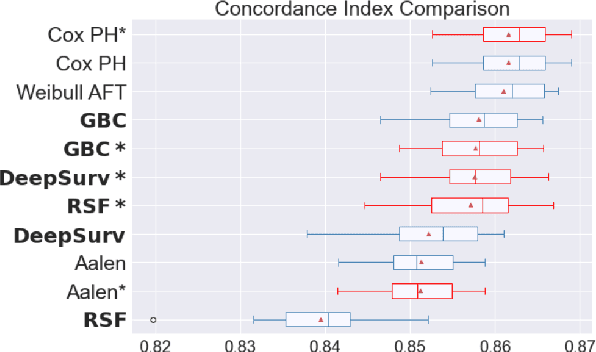

Abstract:Time-to-event analysis is a branch of statistics that has increased in popularity during the last decades due to its many application fields, such as predictive maintenance, customer churn prediction and population lifetime estimation. In this paper, we review and compare the performance of several prediction models for time-to-event analysis. These consist of semi-parametric and parametric statistical models, in addition to machine learning approaches. Our study is carried out on three datasets and evaluated in two different scores (the integrated Brier score and concordance index). Moreover, we show how ensemble methods, which surprisingly have not yet been much studied in time-to-event analysis, can improve the prediction accuracy and enhance the robustness of the prediction performance. We conclude the analysis with a simulation experiment in which we evaluate the factors influencing the performance ranking of the methods using both scores.
Interference Management in 5G and Beyond Networks
Jan 03, 2024Abstract:During the last decade, wireless data services have had an incredible impact on people's lives in ways we could never have imagined. The number of mobile devices has increased exponentially and data traffic has almost doubled every year. Undoubtedly, the rate of growth will continue to be rapid with the explosive increase in demands for data rates, latency, massive connectivity, network reliability, and energy efficiency. In order to manage this level of growth and meet these requirements, the fifth-generation (5G) mobile communications network is envisioned as a revolutionary advancement combining various improvements to previous mobile generation networks and new technologies, including the use of millimeter wavebands (mm-wave), massive multiple-input multipleoutput (mMIMO) multi-beam antennas, network densification, dynamic Time Division Duplex (TDD) transmission, and new waveforms with mixed numerologies. New revolutionary features including terahertz (THz) communications and the integration of Non-Terrestrial Networks (NTN) can further improve the performance and signal quality for future 6G networks. However, despite the inevitable benefits of all these key technologies, the heterogeneous and ultra-flexible structure of the 5G and beyond network brings non-orthogonality into the system and generates significant interference that needs to be handled carefully. Therefore, it is essential to design effective interference management schemes to mitigate severe and sometimes unpredictable interference in mobile networks. In this paper, we provide a comprehensive review of interference management in 5G and Beyond networks and discuss its future evolution. We start with a unified classification and a detailed explanation of the different types of interference and continue by presenting our taxonomy of existing interference management approaches. Then, after explaining interference measurement reports and signaling, we provide for each type of interference identified, an in-depth literature review and technical discussion of appropriate management schemes. We finish by discussing the main interference challenges that will be encountered in future 6G networks and by presenting insights on the suggested new interference management approaches, including useful guidelines for an AI-based solution. This review will provide a first-hand guide to the industry in determining the most relevant technology for interference management, and will also allow for consideration of future challenges and research directions.
System Log Parsing: A Survey
Dec 29, 2022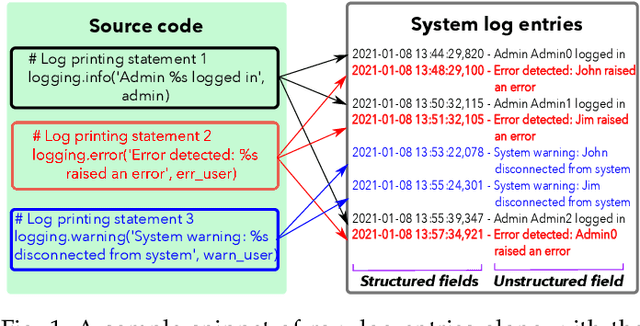
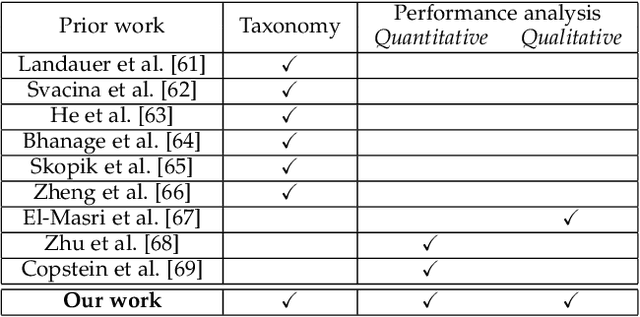
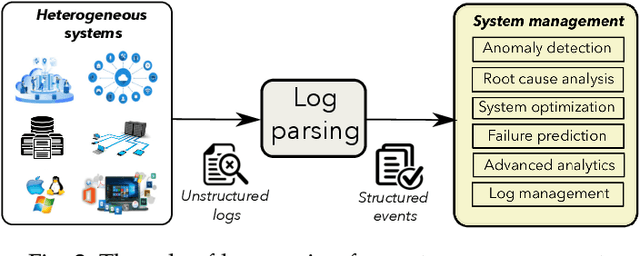
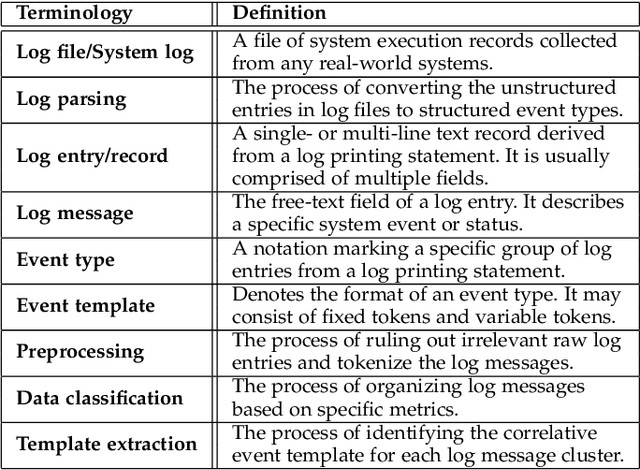
Abstract:Modern information and communication systems have become increasingly challenging to manage. The ubiquitous system logs contain plentiful information and are thus widely exploited as an alternative source for system management. As log files usually encompass large amounts of raw data, manually analyzing them is laborious and error-prone. Consequently, many research endeavors have been devoted to automatic log analysis. However, these works typically expect structured input and struggle with the heterogeneous nature of raw system logs. Log parsing closes this gap by converting the unstructured system logs to structured records. Many parsers were proposed during the last decades to accommodate various log analysis applications. However, due to the ample solution space and lack of systematic evaluation, it is not easy for practitioners to find ready-made solutions that fit their needs. This paper aims to provide a comprehensive survey on log parsing. We begin with an exhaustive taxonomy of existing log parsers. Then we empirically analyze the critical performance and operational features for 17 open-source solutions both quantitatively and qualitatively, and whenever applicable discuss the merits of alternative approaches. We also elaborate on future challenges and discuss the relevant research directions. We envision this survey as a helpful resource for system administrators and domain experts to choose the most desirable open-source solution or implement new ones based on application-specific requirements.
Experimental Comparison of Semi-parametric, Parametric, and Machine Learning Models for Time-to-Event Analysis Through the Concordance Index
Mar 13, 2020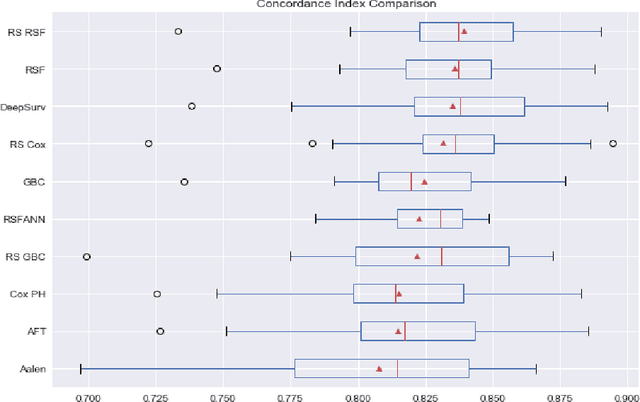
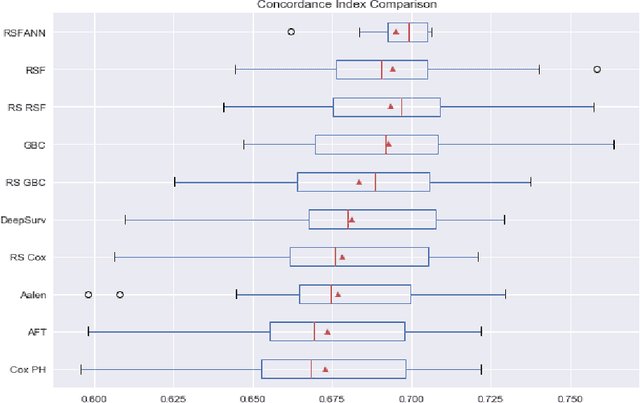
Abstract:In this paper, we make an experimental comparison of semi-parametric (Cox proportional hazards model, Aalen's additive regression model), parametric (Weibull AFT model), and machine learning models (Random Survival Forest, Gradient Boosting with Cox Proportional Hazards Loss, DeepSurv) through the concordance index on two different datasets (PBC and GBCSG2). We present two comparisons: one with the default hyper-parameters of these models and one with the best hyper-parameters found by randomized search.
 Add to Chrome
Add to Chrome Add to Firefox
Add to Firefox Add to Edge
Add to Edge